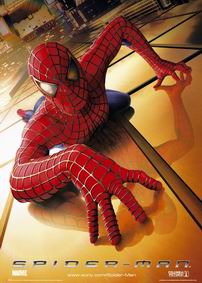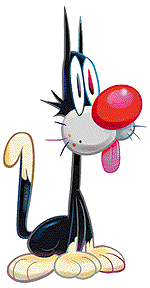Animated Cartoons Or Not ?
Is there a reason to separate the terms “animation” and “cartoons”? Is the term “animated cartoons” too restrictive to describe the evolution of animated entertainment? From the earliest days of the medium, most animated films were based on characters from newspaper comic strips, so animation became directly connected to “cartoon” characters. Disney, Warner Brothers and MGM certainly set the mold for animation to be strongly associated with cartoony characters. For most of its history, producers of animation have accepted the fact that animated works were by necessity cartoons. This is no longer the case, as we have moved into an era of CGI photorealistic computer graphics as well as more accessible platforms for animation creation and distribution. These evolutions present us with new questions to ponder. The first question is what good animation is, or more specifically what it isn’t? The second question is what good cartoons are and what they aren’t?
Certainly there have always been experimental animated films that were not cartoons in the traditional sense. Cartoons are based on the notion of abstraction and caricature. They tend to extract the essence of a subject and highlight and exaggerate certain aspects of reality. As mentioned in previous articles, Disney in an attempt to push animation more into the filmmaking mainstream brought a heightened sense of reality to his features. This was both positive and negative in terms of furthering the medium. It certainly did prove that animation could be more than just caricature but it also blurred the lines between cartoons and animation. A cartoon de-emphasizes the appearance of the physical world in favor of the idea of it. It is actually an interpretation of the “real” world. A cartoon always leaves a varying degree of reality to the viewer’s imagination. As a picture becomes more realistic, it is less open to interpretation. It is removed from abstraction and caricature. Following this logic towards photorealism, the work eventually ceases to be a cartoon. An animated cartoon therefore must allow for some interpretation of reality by the viewer. Realism is strived for in how the drawings appear to move and carry weight and perhaps in how the characters act and react.
Based on this premise, “special effects” movies are not cartoons. In movies like Star Wars, Spiderman or Jurassic Park, the animated characters are clearly intended to blend seamlessly into their real world settings. This blending is intended to achieve the effect of a cohesive reality, one of consistent believability. The aliens, dinosaurs, or super heroes are not intended to be cartoony, and the effect is one of photorealism. This is totally different than with films like Who Framed Roger Rabbit or Space Jam or Looney Tunes: Back in Action. In these “hybrid” movies, the animated characters are still clearly cartoony. They interact with their environment, but what is important is not the realism but the nature of the characters, which are still cartoons. So animation does serve the role of transcending reality and fantasy but it doesn’t have to be a cartoon to achieve this goal.
So what makes animation good or bad and can there be such a thing as bad animation? There is no clear answer to this question, only opinion. Certainly to judge animation, we must consider the context of how it is used. If the animation is intended to blend into a photorealistic world as in Jurassic Park or Spiderman, then it must be judged on how seamless and consistent it is in achieving that goal. Animation can only be considered good or bad within each specific context based on how successfully it achieves its intended goal. Bad animation only exists when the animated work fails to meet the requirements of its intended context. Is the Disney or Pixar style of animation good and Anime or other limited animation styles bad? It’s all a matter of contexts and what the filmmaker is trying to accomplish. If you move away from photorealistic animation toward caricature the discussion becomes a matter of artistic style and interpretation and most importantly on how well the artist achieves his/her vision, whatever that might be.
Perhaps the real dilemma is the distinction between caricature and humor. Are cartoons by definition meant to be humorous? Caricature and abstraction aren’t necessarily focused on humor but rather on extracting a simplified viewpoint of a more complex subject. Humor is a specialized approach to entertainment. The inclusion of humor in a cartoon or the lack of humor in a cartoon can be judged in a fashion similar to judging the quality or style of animation used in a film. As stated above, if the style of animation achieves its intended goal in the context in which it is being used then it is successful. If a cartoon is meant to be humorous and it isn’t received by the audience as funny or entertaining then it has failed. It is beyond the scope of this article to try to explain why something is funny or not, but certainly we all can agree that if a cartoon is intended to be humorous and it doesn’t make the audience laugh or at least smile, it isn’t funny. At least to my way of thinking, a cartoon is an abstract caricature of reality but a cartoony cartoon is meant to be more than that. It also has to be very funny.

Certainly there have always been experimental animated films that were not cartoons in the traditional sense. Cartoons are based on the notion of abstraction and caricature. They tend to extract the essence of a subject and highlight and exaggerate certain aspects of reality. As mentioned in previous articles, Disney in an attempt to push animation more into the filmmaking mainstream brought a heightened sense of reality to his features. This was both positive and negative in terms of furthering the medium. It certainly did prove that animation could be more than just caricature but it also blurred the lines between cartoons and animation. A cartoon de-emphasizes the appearance of the physical world in favor of the idea of it. It is actually an interpretation of the “real” world. A cartoon always leaves a varying degree of reality to the viewer’s imagination. As a picture becomes more realistic, it is less open to interpretation. It is removed from abstraction and caricature. Following this logic towards photorealism, the work eventually ceases to be a cartoon. An animated cartoon therefore must allow for some interpretation of reality by the viewer. Realism is strived for in how the drawings appear to move and carry weight and perhaps in how the characters act and react.

Based on this premise, “special effects” movies are not cartoons. In movies like Star Wars, Spiderman or Jurassic Park, the animated characters are clearly intended to blend seamlessly into their real world settings. This blending is intended to achieve the effect of a cohesive reality, one of consistent believability. The aliens, dinosaurs, or super heroes are not intended to be cartoony, and the effect is one of photorealism. This is totally different than with films like Who Framed Roger Rabbit or Space Jam or Looney Tunes: Back in Action. In these “hybrid” movies, the animated characters are still clearly cartoony. They interact with their environment, but what is important is not the realism but the nature of the characters, which are still cartoons. So animation does serve the role of transcending reality and fantasy but it doesn’t have to be a cartoon to achieve this goal.
So what makes animation good or bad and can there be such a thing as bad animation? There is no clear answer to this question, only opinion. Certainly to judge animation, we must consider the context of how it is used. If the animation is intended to blend into a photorealistic world as in Jurassic Park or Spiderman, then it must be judged on how seamless and consistent it is in achieving that goal. Animation can only be considered good or bad within each specific context based on how successfully it achieves its intended goal. Bad animation only exists when the animated work fails to meet the requirements of its intended context. Is the Disney or Pixar style of animation good and Anime or other limited animation styles bad? It’s all a matter of contexts and what the filmmaker is trying to accomplish. If you move away from photorealistic animation toward caricature the discussion becomes a matter of artistic style and interpretation and most importantly on how well the artist achieves his/her vision, whatever that might be.

Perhaps the real dilemma is the distinction between caricature and humor. Are cartoons by definition meant to be humorous? Caricature and abstraction aren’t necessarily focused on humor but rather on extracting a simplified viewpoint of a more complex subject. Humor is a specialized approach to entertainment. The inclusion of humor in a cartoon or the lack of humor in a cartoon can be judged in a fashion similar to judging the quality or style of animation used in a film. As stated above, if the style of animation achieves its intended goal in the context in which it is being used then it is successful. If a cartoon is meant to be humorous and it isn’t received by the audience as funny or entertaining then it has failed. It is beyond the scope of this article to try to explain why something is funny or not, but certainly we all can agree that if a cartoon is intended to be humorous and it doesn’t make the audience laugh or at least smile, it isn’t funny. At least to my way of thinking, a cartoon is an abstract caricature of reality but a cartoony cartoon is meant to be more than that. It also has to be very funny.

0 Comments:
Post a Comment
<< Home